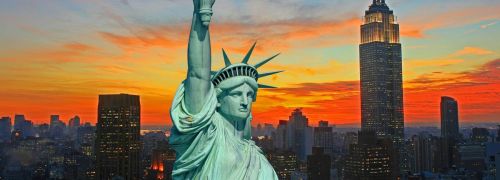Travel highlights New York

Botanical Garden
The New York Botanical Garden is one of the oldest botanical gardens in America - it is also one of the largest and features 50 gardens and collections, horticultural displays in several pavilions, including approximately 50 acres of New York's original Forest.
Bronx Zoo
The largest metropolitan zoo in the United States, the Bronx Zoo comprises 265 acres of parklands and naturalistic habitats -- home to over 4,000 animals, many of which are endangered or threatened species. The Zoo contains a number of unique habitats -- areas designed to replicate the homes of their inhabitants as closely as possible. Jungle World, for instance, is an indoor rain forest where Asian gibbons, hornbills, tapirs, and many other rare species live among equally rare and beautiful plants and trees. Himalayan Highland Habitat is the home of the red panda, snow leopard and white-naped crane.
Central Park
Central Park is one of the urban wonders of the world, a green oasis in the great concrete, high-rise landscape of New York City. It is so naturally part of the Manhattan environment that many people may not realize it is entirely man-made. Surprisingly, you can drive through Central Park, as Sixth Ave. ends there, and if you drive through the center of the Park, you will end up in Harlem.
China Town
Chinatown New York City, the largest Chinatown in the United States, is located in one of the oldest neighborhoods in Manhattan. Founded in the late 1870's by Chinese immigrants, Chinatown offers a unique historical and cultural experience not found anywhere else in the world.
Downtown and Wall Street
This part of New York has a little something for everyone. it's at the very heart of international finances. Home to Wall Street, see the frenzied New York Stock Exchange and Mercantile Exchange, The World Financial Center with its beautiful Winter Garden, and Federal Reserve Bank. In Bowling Green Park, where Peter Minuit traded $24 worth of goods for Manhattan Island.
Empire State Building
The Empire State Building is a 102-story Art Deco skyscraper. Its name is derived from the nickname for the state of New York. It stood as the world's tallest building for more than forty years, from its completion in 1931 until construction of the World Trade Center's North Tower was completed in 1972.Following the destruction of the World Trade Center in 2001, the Empire State Building again became the tallest building in New York City.
Greenwich
For over 100 years, this small area below 14th Street and west of Broadway has been a Mecca to the creative, rebellious and Bohemian. Although today no starving artists could afford to live here, the vibe still lingers and the beat goes on... Downtown charm is personified in lots of low-rise townhouses, thumbnail-size gardens, secret courtyards and a serpentine layout of streets.
Statue of Liberty
The Statue of Liberty has been the symbol of New York and of America's promise for over 100 years. Now handsomely restored, the statue still offers a "climb to the crown" along a narrow interior staircase. Nearby, Ellis Island and its Immigration Museum represent an even more ambitious restoration effort. The island's main building, where 12 million immigrants arrived and were processed from 1892 to 1954, now tells their fascinating story. Both the statue and the island are accessible only by ferry from Manhattan's Battery Park or from Liberty State Park in Jersey City.
Times Square
You've seen it in hundreds of movies and it is the most famous square on planet earth - no trip to New York would be complete without a visit to spectacular Times Square. Times Square has achieved the status of an iconic world landmark and has become a symbol of its city. Times Square is packed with popular New York restaurants such as Frankie and Johnnie's and Zanzibar as well as Broadway theaters, hundreds of places to shop, concert venues, festivals, street performers, and more.